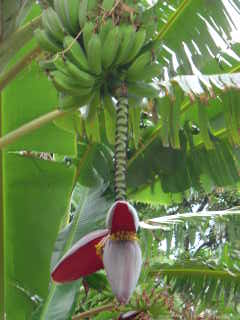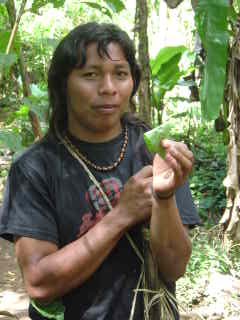|
|||||||||||||||
|
|
|||||||||||||||
|
Jan Yatsko, Artist email: For those people who wish to contact me through email, please see the note on my Contact Page. |
|||||||||||||||
 |
|||
|
Take a bi-monthly peek into artist Jan Yatsko’s daily life in Costa Rica. Humor, reflection and inspiration are woven into her experiences that revolve around her passion for art, nature, culture and food. |
|||
|
Please scroll down for the most recent back issue |
|
February 2008 “Time flies like an arrow; fruit flies like a banana.” Groucho Marx Down here we all eat bananas, plantains, guineos and cuadrados. We also eat green bananas, ripe plantains, green plantains, black and purple guineos, pig guineos and apple bananas. Some you cook and some you peel and eat. To me, not only do they all look like bananas, but all the trees look the same too. It’s enough to make your head spin, especially if the only banana you grew up with was the peel and eat variety. I decided to ask my Costa Rican friends, Guido, Mayi, Hortensia, Eugenia and Luis (all pictured below), the experts regarding these tropical foods. |
|||
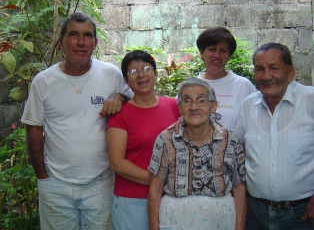 |
|||
|
Hortensia, the 83 year old mother of Mayi and Eugenia, first explained the difference between the shape and color of the leaves. Mayi and Eugenia told me differences between the shape of the fruit and then made my mouth water when they described typical recipes. Guido, Mayi’s husband and experienced gardener, explained the growth of banana trees. Luis, Hortensia’s husband, and I had the best task...we were the taste testers. |
|
|
|
Guineo leaves are very wide and strong and are the preferred leaves to make tamales. The guineo fruit is softer and requires less time to cook. For lunch, Mayi served a typical dish of cooked fresh beans with pieces of cooked guineo in a delicious bean broth. The addition of rice to the broth made it a complete meal. Yum! Humans are not the only ones to eat bananas. In our backyard, sliced bananas and plantains are placed in a feeder to be eaten by many species of birds (like woodpeckers and Baltimore Orioles), iguanas and squirrels; and butterflies feed off of the sweet fruit of very ripe bananas. Guido told me that a banana tree will produce fruit when it is about the same height of a man. It will produce one large cluster of fruit each year for about 2-3 years. Considering the amount of bananas we all eat, one can get a good mental picture of the size of banana plantations in order to keep us all happy. Next time you reach for a bunch of bananas at the grocery store check the label. One of Costa Rica’s major exports to the USA is bananas. PATACONES A great before dinner snack for guests with drinks like lemonade, margaritas or mojitos. Or use in place of french fries with fish or a good hamburger. 2 green plantains cooking oil salt Peel the plantains and scrape the fruit slightly with a knife. Cut into slices about an inch thick and fry lightly in a pan with 1/4” of oil. Remove from the pan and squash them flat with the bottom of a glass into the shape of a cookie. Fry them again before they cool off. Sprinkle with salt to taste. Many Costa Ricans dip them into refried beans. Yum!!!! |
|
Going to the dogs...and cats A year ago a group of people formed an organization to help abandoned animals in our town of Atenas. These seven very dedicated people accept sick, hungry and abandoned dogs and cats into their homes to nurse them back to health with love and veterinary care. An adoption and castration program is also in place. Donated funds pay for food and castrations for the abandoned animals under the care of these people, who themselves are living on a limited income. I decided to help the group by donating one of my paintings to be auctioned off. I’m pictured below with Lorna and Darrell from Seattle who purchased “Let Sleeping Dogs Lie” (see my Gallery page on my web site). The group told me that the organization’s funds were down to nearly zero when the couple purchased the painting. You can learn more about the group by visiting: http://www.costa-rica-live.com/AnimalesAtenas/Adopciones.html Copyright Jan Yatsko February 2008
|
|
|
|
|
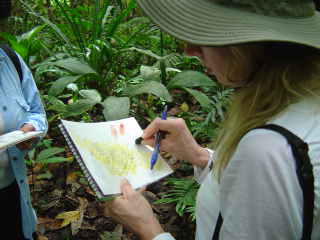 |
|
Holistic Medicine To most of us who are accustomed to the ways of modern medicine, all of the shaman-healer rituals might be regarded as witchcraft. Perhaps the fanfare of the Bribri/Cabecar healing ceremony is a way to prepare the mind of the sick person to believe that a cure is possible. All of us in the Explore & Create in Costa Rica tour learned about medicinal rain forest plants that are chemically copied to treat many illnesses. Go back and read the first couple of sentences of the second paragraph. Next read what constitutes Holistic Medicine, a healing practice that is becoming widely used throughout the world. Holistic Medicine is a system of health care that looks at the whole person. It takes into account the physical, nutritional, environmental, social, spiritual and lifestyle values of the person. It focuses on education and personal responsibility to achieve balance and well-being. I don’t see much difference between the philosophies of all the healers mentioned. Copyright Jan Yatsko March 2008
|
|
May 2008 “If you want your campfire under control, throw some tortillas on the coal.” Latin American proverb In Latin America, tortillas are served with your meal like bread is served in a typical North American restaurant. Food statistics in the US show that tortilla’s popularity has surpassed the bagel and the muffin to come in second behind bread. In Costa Rica, tortillas that are served in restaurants are produced commercially, but occasionally you will find a place or a friend’s home that serves them freshly made. Yum! Those are the places you keep going back to. I am lucky to have a Costa Rican friend who makes them fresh daily. Hortensia, who is like my mom away from home, has many years of experience making tortillas. She will turn 83 in August and more than 40 years ago, she supported herself and her children by making tortillas. |
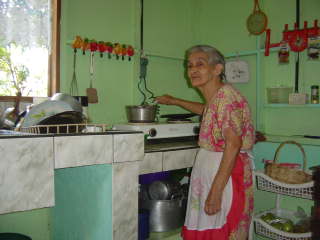 |
|||
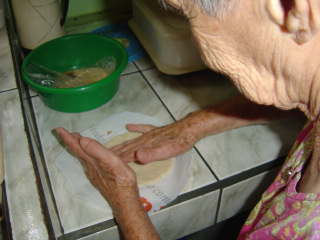 |
|||
|
She would rise at 4:00 AM each day to have her corn ground into flour and return home to begin the task. Hortensia would form a corn dough ball larger than the size of a golf ball, flatten it on a piece of plastic and begin to twirl the plastic on the table top as she expertly created a perfect 6” circle, 1/8” thick. Next the tortilla was placed on a hot griddle (comal) and browned on both sides for 20 seconds. Her hot tortillas stayed warm in a banana leaf lined basket as they were quickly delivered to her customers by her young children. Hortensia’s technique has not changed in 40 years, except her corn flour is now purchased at the neighborhood store and her homemade tortillas are reserved only for her grandchildren and close friends. |
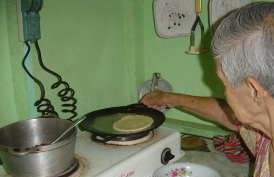 |
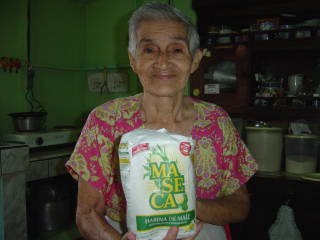 |
||
|
Corn supplied the energy source (starch) and protein for the early Indians and was an integral part of their lore. According to many Indian legends (including the Bri Bri of Costa Rica), corn was considered the “seed of life” and that humans were made of corn by the Gods. The Aztecs served flat corn breads to the Spanish conqueror Hernando Cortez when he arrived in the New World in 1519. He wrote about it in his letter to King Charles of Spain giving the bread the name “tortilla”. A “gallo” is the most popular way to eat tortillas in Costa Rica and can be found on many typical restaurant menus. It is a palm-sized sandwich. Place the tortilla in the palm of your hand and fill it with chicken, fish, meat, egg, beans, cheese or picadillo (a traditional meat and vegetable mixture) and fold in half. Delish!!! A gallo on a restaurant menu is often a lighter version of a main entrée. I remember our early bicycling vacations in Costa Rica when Tom and I would pass up the gallos listed on the menus for something else. Our ignorance was a big mistake. Now you know what a gallo is so go ahead and try one! |
|
Summer Vacation Try making your own tortillas. Latin food markets and major grocery stores will carry the Maseca brand of corn flour (masa harina). Follow the directions on the bag. Invent your own fillings or cut the tortillas into triangles, place them on a baking sheet and toast in the oven. Salt lightly. There is nothing like your own fresh tortilla chips. Copyright Jan Yatsko May 2008 |
|
January 2009 “We should look for someone to eat and drink with before looking for something to eat and drink.” Epicurus I was raised in an individualistic culture (USA) and now I am living in a collectivistic culture. What led me to this conclusion was book entitled “Yes! 50 Scientific Proven Ways to be Persuasive” and an afternoon making tamales with a Costa Rican family. It is not easy for one person to make tamales. The process takes several days and benefits from the collective efforts of a family plus friends sprinkled in for “spice”. A pampered pig is killed and cooked, banana leaves are gathered and steamed, vegetables and rice are cooked and corn is ground and cooked into a mashed potato like consistency. Next an assembly line of hands fills, folds and ties the banana leaves into neat little packages. Over a wood fired stove, the tamales cook in a 20 quart pot until the corn masa is firm. One afternoon I helped a family fold and tie the filled banana leaves. My many years of origami folding and fiber arts reduced my learning curve to only a few initial sloppy efforts before I became a pro like a Costa Rican. Everyone’s collective help enabled this family to make over 700 tamales. |
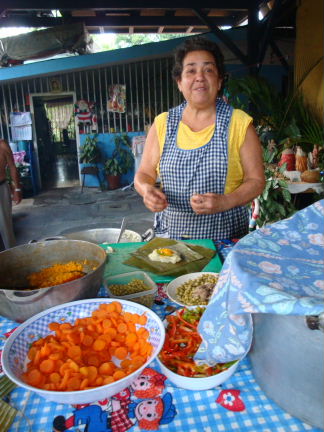 |
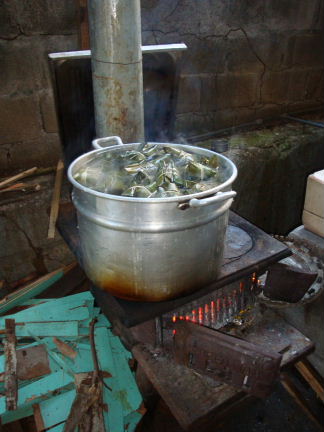 |
|
As stated in the book “Yes! 50 Scientific Proven Ways to be Persuasive” an individualistic culture is found in the US, Canada, Britain and Western Europe and the emphasis is on ME and my uniqueness. In a collectivistic culture found in Asia, Central & South America, Africa and Eastern Europe, the highest priority is WE and the preferences and rights of the group. So how did individualistic and collectivistic cultures emerge? Did some become extinct? The Amish is a “closed” and a collectivistic community within an individualistic culture. If the priority of individualistic cultures is uniqueness, does that mean that collectivistic cultures are able to preserve more of their customs and beliefs? In a collectivistic society, the key element is the ability to share with others a product or a process. In his short story “Camaraderie”, Ronald Kotzsch writes about the importance of sharing food and conversation. Many times Ronald denied himself the food, conversation, laughter and drink offered to him in several group situations around the world because he wanted to abide by his Buddhist beliefs. The people that shared in the food and conversation woke up the next morning feeling energized and happy while Ronald felt ill and alienated from the group. Ronald later discovered after drinking beer and eating fried pork chops for breakfast in a German village that all food eaten in fellowship with good conversation and laughter is “health” food. During the Christmas season in Costa Rica, homemade tamales are given as gifts like cookies are given in the USA. Traditionally, tamales are eaten with family and friends on Christmas Eve. The gift of food is linked with the gift of self. To consume the food is to offer the giver the greatest gift in return. Copyright Jan Yatsko January 2009 |
|
April 2009 “Where I come from we say that rhythm is the soul of life, because the whole universe revolves around rhythm and when we get out of rhythm, that’s when we get into trouble. For this reason the drum, next to the human voice, is our most important instrument. It is special.” ~Babatunde Olatunji, Nigerian Drummer
The Costa Rican national bird, the Yiguirro, has filled the air with a chorus of melodious songs for the past month. Their songs begin at 4:30 AM and continue until sundown. Like their cousin to the North, the Robin, they are following the yearly pattern of mating and nesting as the season changes from one to another. Costa Rican folk lore says that the Yiguirro is “singing for rain”. We are at the end of the dry season and trees, animals and humans are anxiously awaiting the first rain. It happened five days ago. Trees sprouted new buds and the grass turned green overnight. With occasional sunny days and rainy nights, the countryside will soon be bursting with every shade and color of green possible. This is the tropical landscape that every visitor to Costa Rica expects to see. Pattern, rhythm and repetition are a part of our lives and we can interpret them in many ways. Notes skip across the music sheet like dancers on the stage and the sound of each step replicates the beat of a drum. Poets and actors use the rise and fall of their voice and pauses to accentuate a phrase and to create an emotion. A wavy line drawn across the paper reminds us of the times we spent at the beach listening to relaxing rhythmic waves. Movement, rhythm and pattern are part of the seven principles of design and the best way to see this is to observe nature. |
|||||
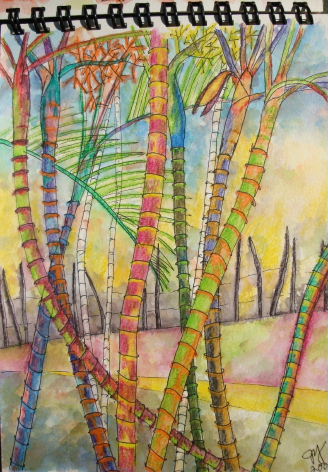 |
|||||
|
I suggest to my students in my travel art journal workshops to look for patterns or a repetition of a theme. Many times it is represented in the art, nature and culture of the country. The pattern (theme) often presents itself from the very beginning and is a connecting thread throughout the whole journal. This happened to me on a trip to Nicaragua. On our first night, Tom and I went to a highly recommended restaurant. Upon sitting down I looked straight ahead and saw through the filtered night light a wooden mask with a large eye staring back at me. On the menu was the name of the restaurant, The Third Eye, and everywhere I went the eye theme reappeared in a different way and in a different place. In our daily lives we have a tendency to overlook the patterns. Being more observant of regular patterns and the changes that occur within those patterns can even save lives. During the devastating tsunami which occurred in Southeast Asia several years ago, the animals and humans whose lives depend on nature’s patterns noticed the changes early and in time to seek higher ground. My hope is that someday a scientist will notice a different pattern in his/her research and discover a new cure for a devastating disease. Copyright Jan Yatsko April 2009 |
|
June 2009 “Creation is a huge beginning not a finished end.” John O’Donohue A month ago I witnessed ecological history. Under the night sky and with the help of infrared light, I saw a 5 foot long endangered leatherback turtle lay her eggs on a beach about 10 miles north of Limon, Costa Rica. To arrive at this special private reserve called La Estacion de las Tortugas (The Turtle Station), I traveled several hours by van and another 30 minutes by outboard boat on the only “road” (canal) system north of Limon, located on the Caribbean side of Costa Rica. For the leattherback to arrive at this beach she traveled the ocean waters from North and South America until the pink spot on the top of her head told her that it was the right time of day and the right place to lay her eggs. From February to June, these soft shelled sea turtles leave the comfort of the water to drag their 1200+ lb. body across the sand and dig a 2 foot deep hole with her back flippers to lay up to 100 white 2” diameter eggs. The effort is so difficult that she groans with every step. It is a mystical rhythm dating back 150 million years. |
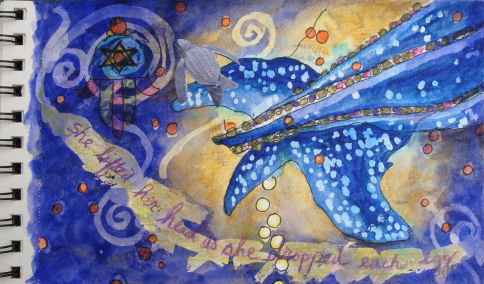 |
|||
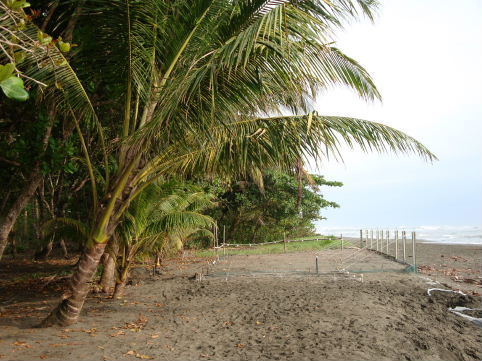 |
|||
|
|
|
Sea turtles become disoriented and frightened by light and if this happens a female will return to the sea without laying her eggs. Infrared light directed at the back half of the turtle was the only available means of seeing the egg laying process. I had to rely on my five senses to observe what was happening. I looked up and saw a partially cloudy sky with the moon peeking through. I heard the constant and rhythmic waves behind me. I looked real hard and under the night sky I blindly began to draw the turtle as she dropped her eggs into the nest. I felt the sand against my face and body as the turtle used her powerful front and back flippers to cover her nest. Then there was silence as she entered the sea. Positive and negative intervention by man will determine the ecological fate of the leatherback turtles. Poachers eat the eggs and meat; bright lights from development disorient the turtles; plastic bags mistaken for jellyfish (their favorite food) plug up the stomach cavity; commerical fishing nets entangle them and global warming is tipping the sexual orientation scale of the eggs to mostly female. Private and national reserves are scrambling to reverse the accelerated decline. Volunteers gather the eggs and place them in protected nest areas, hatchlings are protected from bird predators as they scamper to the ocean and turtles are measured, checked and tagged in an effort to learn more about their behaviors. Even with all the effort, out of 2,000 eggs that are laid, 1,000 will hatch (50% natural/50% from reserve) and only one will survive to adulthood. The animal symbolism of the turtle represents Order, Creation, Patience, Strength, Stability, Longevity, Innocence and Endurance...characteristics that are needed for them to continue for another million years. Copyright Jan Yatsko June 2009 Want to learn more about leatherbacks? 1. www.seaturtle.org has a satellite chart on the movement of tagged sea turtles. 2. Go to www.YouTube.com and type in “Leatherback sea turtles” to view turtles laying eggs and hatchlings struggling to break free of their shell. 3. Visit my new friend (we met on the trip) Patsy’s blog to get another point of view of the same trip I took. http://gonzosincostarica.blogspot.com
|
|
|
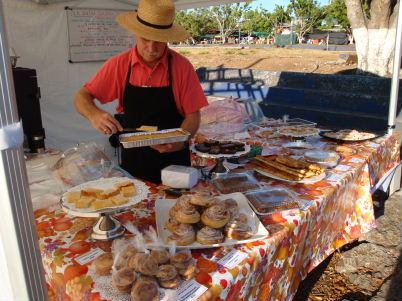 |
|||
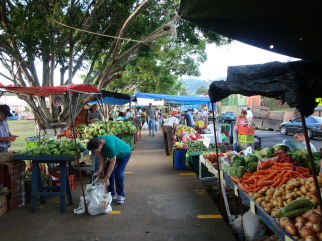 |
|||
|
|
|
We currently earn our living by making American-style bakery items and selling these products at the outdoor farmer’s markets (ferias de agricultor) in Atenas and in a nearby larger town of Grecia. The outdoor markets began about 35 years ago to provide a direct selling opportunity to small farmer’s when the produce markets (mercados) could no longer accommodate the growing demand under one roof. The feria is the place where people connect; it is the pulse of everyday Costa Rican life. Customers can purchase directly from the producer and receive the latest news that is passed verbally from one acquaintance to another. At a feria one can purchase not only fruits, vegetables, meat and cheese, but flowers and plants, clothing, shoes, homemade tortilla chips and fruit jellies, local artisan coffee, shopping bags made from recycled rice sacks, handmade baskets and a variety of prepared foods from bakery items and pupusas to a complete gallo pinto breakfast, all at prices less than those offered in the mercados. As you walk through the feria, listen to the words that the stand holders shout to get the customer’s attention. “Lleva mango, lleva cebolla (onion), lleva flores (flowers)” as they tell you to take home their particular product. “Solo bueno” means that only the best products are sold to you. When a customer says “regalame una...” (give me a...) you are in business, but when a customer says “ahora pasamos” (we’ll come by later), that is a polite way of saying “no thanks”. What Tom and I love most about the ferias is the family atmosphere. Your purchase goes directly to the family that provided and sold the product and after awhile frequent customers become “like family” and occasionally who wouldn’t want to give them a few extra items free! Our Costa Rican feria neighbors have embraced us as family and at the end of the day, they wish us another good week ahead along with an occasional free item from their stand. Copyright Jan Yatsko August 2009
|
|
Can you name the red fruit? |
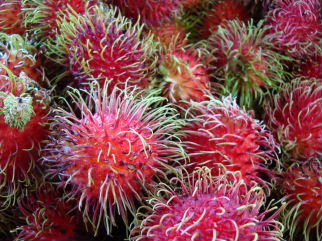 |
|||
|
What is the Spanish OR English name for this red fruit? Hint. They are in season in Costa Rica during the months of July-September. The first person to respond with the correct answer will win an original Jan Yatsko framed painting depicting a typical Costa Rican scene. Please respond to janyatsko@racsa.co.cr and include a shipping address. I will reveal the answer in the next newsletter. Suerte...Good luck! |
|||








